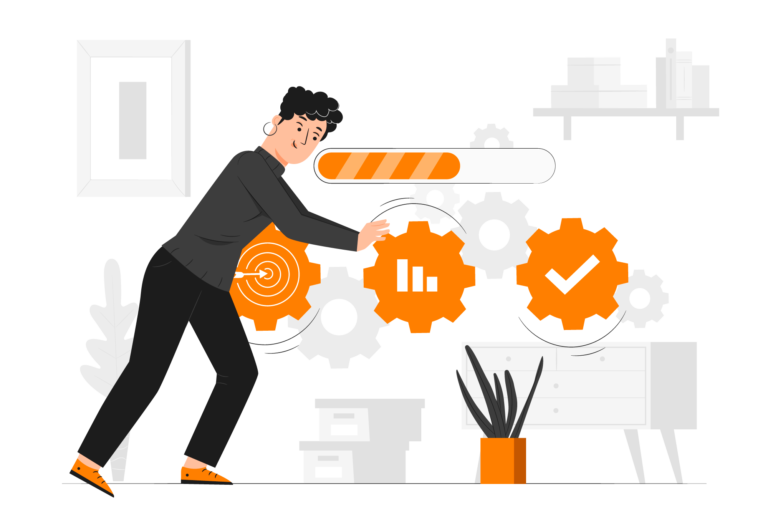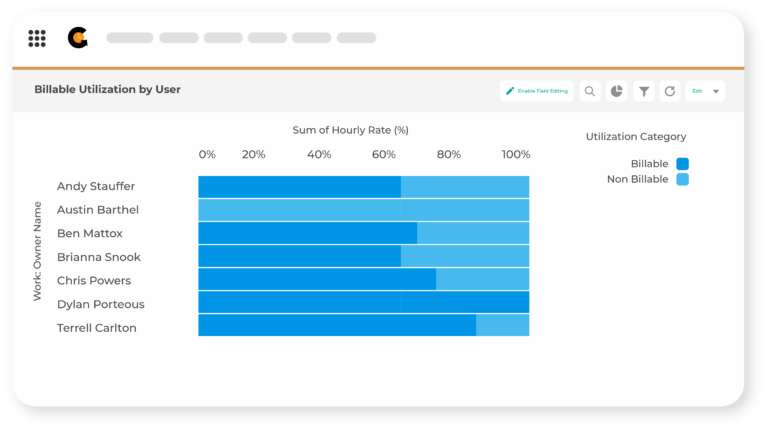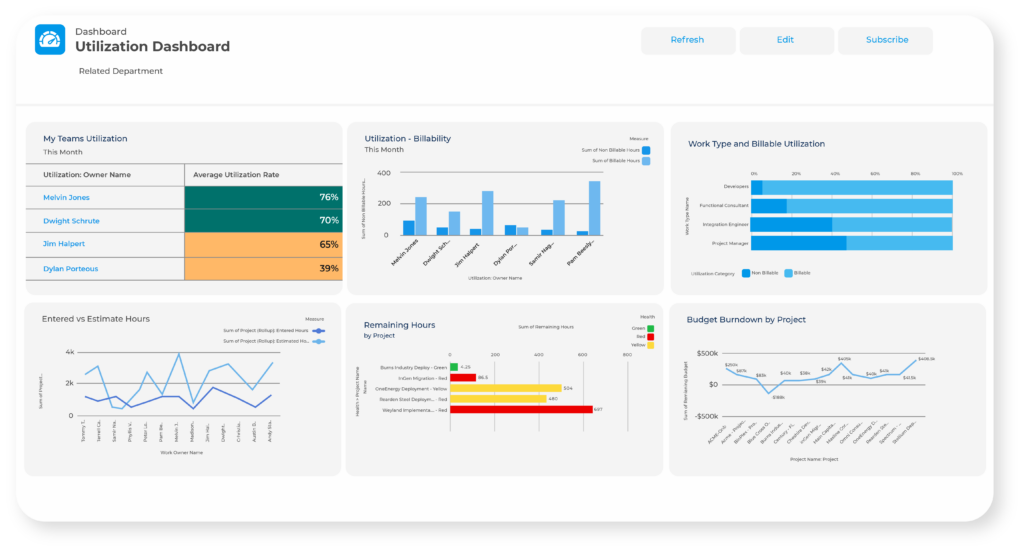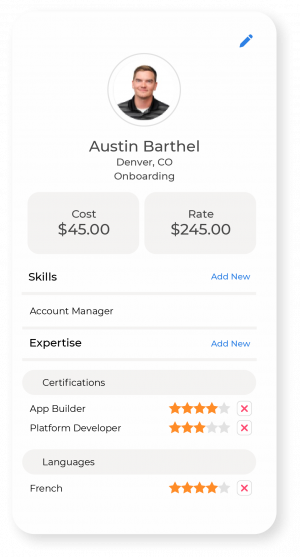
FIND OUT HOW...
Billable Utilization on Salesforce
Looking for the right Utilization solution? Our explainer video demonstrates just how easy it can be to manage on Salesforce using Cloud Coach.

Looking for the right Utilization solution? Our explainer video demonstrates just how easy it can be to manage on Salesforce using Cloud Coach.
Billable utilization is a key performance indicator (KPI) used by nearly all professional service firms. It measures the number of hours employees spend generating revenue for the business as a percentage of total hours available.
Billable utilization is similar to other rates measuring the efficient use of resources in a commercial context. Professionals sometimes refer to it as the “consulting utilization rate,” “employee utilization rate,” “billable rate,” or “utilization percentage.”
The goal of every professional service manager is to improve the billable utilization rate. It is a tool they can use to evaluate the performance of the business in general and individual consultants.
The billable utilization rate is valuable for several reasons. First, it lets you track profitability. The higher it is for an individual employee, the more earnings they generate for your enterprise.
It also helps prevent cash flow and profitability issues. If you notice the rate dropping over time, it indicates you are no longer using your resources as effectively as you did in the past. You can then explore what might be driving the change, such as poor scheduling, lack of training, and poor capacity planning.
Lastly, billable utilization helps staff better define their roles. Billable employees should focus on billable tasks, while non-billable workers should work on non-billable elements of the business.
Though billable utilization is most closely associated with financials, billable time is often synonymous with “customer time” so a higher billable utilziation rate also informs that your delivery team is spendin more time providing value to your clients than sitting idle on the bench or working on internal activities.
Professional Services teams are under more pressure than ever to deliver more, with fewer resources at their disposal. In this webinar, we explain how you can add more value with less effort!
Non-billable utilization or non-billable work refers to time spent on tasks that are essential for the organization’s development and future success but don’t generate revenue from clients. Examples of non billable hours include support services, marketing, training sessions, administrative tasks, and internal projects. It’s important for companies to have a categorization for Non billable meaning so that employees can easily mark this on their time entries when tracking non billable work.
Professional service firms sometimes refer to non-billable utilization as “productive utilization.” This figure captures how much time employees spend on background revenue-generating activities that the firm cannot charge customers for directly.
All professional service firms have non-billable utilization rates greater than zero. However, excessively high rates may indicate a bloated internal bureaucracy or too much time spent on non-productive tasks.
ADDITIONAL LINKS

Increasing billable utilization rates can improve your organization’s operations significantly. Getting the balance right drives profitability, client engagement, and employee satisfaction.
No firms achieve a 100 percent billable utilization year-round. However, there are proven strategies you can implement to get closer to that figure.
Non-billable time is unavoidable. However, it shouldn’t account for the lion’s share of employees’ time. If it does, it suggests you’re using the wrong tools.
Generally, high non-billable hour issues emerge from three areas: sales, skills, and management.
Sales are may be difficult to quickly resolve. You can address a lack of demand by improving your marketing and working with third-party agencies focusing on SEO, PPC, and conten. What’s more important is to communicate the available capacity to your sales organization. This can inform decisions such as taking more services inhouse versus partners and perhaps accepting a lower margin on projects and rates for a period till demand picks up again.
Skills gaps are trickier to correct. Consulting firms with high non-billable hours often take on projects without the proper expertise. Employees spend hours educating themselves during a project because they don’t have pre-existing knowledge.
You can address this problem by conducting more training sessions or employing consultants with relevant skills. You can also be more selective with your clients, focusing more on those in your niche instead of branching out.
Lastly, you may need to resolve management issues. Leaders in your firm may be delegating work inefficiently.
To correct this, ensure you use the right software to organize employees’ time. Also, check managers in your organization understand how to optimize workers’ schedules. Improper planning can generate substantial inefficiencies in your organization.
Traditionally, consulting firms tracked individual employees’ billable utilization rates to measure performance. However, you can also apply this metric across your entire organization to see if you are moving in the right direction.
Proper tracking shows whether your leadership drives are effective and where you are over-utilizing – where employees spend too much time with clients. Sharing rates across the entire firm also gives managers in different departments a more accurate picture of their performance. If utilization rates are higher in one part of the firm than another, you can transfer employees to compensate. Therefore, tracking business-wide billable utilization is helpful because it doesn’t increase costs.
You can meet additional demand internally without hiring contractors and freelancers.
You can also drive better billable utilization by establishing benchmark rates and working towards them.
There are two ways to do this:
Most consulting firms prefer the second approach: setting internal billable utilization rates. That’s because tracking industry rates can be challenging and, sometimes, sub-optimal.
Another method for improving billable utilization rates is to use enhanced time-tracking software. These tools let you see how long employees spend with high accuracy, giving you more confidence in your utilization KPIs. They also automate time tracking, reducing your administrative overhead – something we explain in more detail below.
Lastly, you can drive better billable utilization by improving your reporting. Professional software can keep you apprised of your daily, monthly, and quarterly utilization rates, showing your organization’s performance over time. This information then provides a robust basis for implementing management and staffing changes.

Calculating the billable utilization rate of an employee is easy. You take the hours they worked on billable tasks and divide it by the total working hours.
Suppose you hire an employee on a 45-hour weekly contract who spends five hours per week on administrative tasks, replying to emails, scheduling and attending meetings. That would imply a billable utilization rate of 89% – pretty good.
Next, you hire an employee on a 40-hour contract, and she spends 20 hours a week arranging work, studying for clients, and answering the telephone. She only spends 20 hours on billable tasks, implying a billable utilization rate of 50% – not so good.
In rare circumstances, you can have utilization rates over 100%. Suppose you employ a colleague for 30 hours per week, but he spends 40 billable hours with clients. That would imply a utilization rate of 133% because he is working longer than contracted. Working practices like these are sustainable for commission-based workers but not usually for standard salaried employees.
With modern tools, you don’t need to calculate billable utilization yourself. Software that integrates with your timetabling can do it for you. Services show you metrics for individual employees and the company as a whole. You can then track everything from a single dashboard and flag utilization issues for specific employees:
Cloud Coach also provides teams the ability to create unique reports so your organization can focus on the most pertinent objectives. For these reasons and many others, Cloud Coach is one of the best options available on the market for built-on-Salesforce solutions helping organizations deliver successful projects of all sizes and shapes.
The formula for the billable utilization rate is:
Billable utilization (%) = Number of hours an employee works on billable tasks / Total available working hours ✕ 100%
For instance, if you hire an employee on a 40-hour contract who spends 32 hours per week generating revenue from clients, their utilization rate is 80 percent.
You can also calculate your organization’s total billable utilization rate with the following formula:
Organizational billable utilization (%) = Number of hours all employees spend on billable tasks / Total contracted working hours ✕ 100%
When calculating organizational billable utilization, do not average individual employee billable utilization percentages. That’s because staff members may work different hours. Instead, add the total number of hours your employees spend on billable tasks and divide by the sum of contracted working hours.
Some firms refer to organizational billable utilization as the “capacity utilization rate.” This metric shows you how your organization is performing as a whole.

According to industry benchmarks, a good billable utilization rate for professional service firms is between 70 and 80 percent. Lower figures suggest you aren’t using resources effectively, while higher ones suggest your staff may not have sufficient time to conduct essential tasks to support future revenue generation.
For example, suppose your employees spend 100 percent of their time with clients generating revenue. At face value, it seems great. Every hour you pay them, they earn money for the firm.
However, long term, these setups can be damaging. A 100 percent utilization rate probably means your employees aren’t training or conducting research for their clients. It could also indicate they are working longer than their contracted hours, which may not be sustainable and could lead to burnout. Employees who leave to join rival firms with better working conditions increase your recruitment costs and deprive you of their expertise.
By contrast, if your billable utilization rate is low, it could reveal you aren’t selling your team on your projects. They might be sitting in the office, twiddling their thumbs instead of working with clients. Consultants may not want to take on particular tasks and require direct management intervention.
With that said, a low billable utilization rate isn’t necessarily bad if you have a good reason. For example, let’s say you just won a multi-year contract with an aerospace firm. Spending extra time accumulating the necessary skills can help you deliver on your service agreement and generate higher revenues in the future. Several consultants might need to spend a week researching for the client to ensure a quality experience.
You might also have a lower billable utilization rate because you are investing in new technology. Training team members on new systems is an investment in the future because it leads to higher productivity.
As such, the billable utilization rate is a context-specific metric. That’s why it’s critical to evaluate the figure and consider what might be driving it. Ask whether the amount of time consultants dedicate to non-billable tasks is acceptable compared to internal standards and your industry.
Salesforce is an industry leading CRM platform trusted by over 200,000 organization across the globe. What most people don’t know is that it is also a renowned Platform for hosting custom applications or one of their thousands of AppExchange partners that have added functionality to extend your CRM.
These softwares can let you automate various processes, improving efficiency, and integrate to your existing CRM data. Invoicing is notoriously prone to errors in the professional services industry. However, with Salesforce, you can automate the process in with third party tools such as Cloud Coach.
You can also get more solid time tracking which eliminates the need for manual entry. Salesforce provides management with a comprehensive overview of how employees spend time during projects, negating the need for costly administration at the head office.
Salesforce reporting is also helpful, particularly when combined with Cloud Coach. You can see precisely how your colleagues spend their time at a granular level, providing deeper insights into your operations. Avoiding switch costs is easy because you don’t have to import time data into your billing software. The service automates the entire process.
Finally, Salesforce and Cloud Coach let you consolidate your technology stack. You can eliminate disjointed solutions and get a comprehensive time management facility via a single piece of software. This approach offers various benefits, including greater ease of use, time-saving, and reduced licensing fees.
Enhancing documentation for better billable utilization in a business context involves refining the practices and protocols associated with record-keeping, particularly those related to services and transactions billable to clients or customers. A robust documentation system is a critical underpinning of any organization committed to achieving peak performance, ensuring accurate measurement and maximization of billable hours or services.
A key benefit of delivering improved documentation is that it fosters transparency and clear communication between the service provider and the client. Parties can easily identify billable services, thus reducing disputes over payments and facilitating smoother transactions. Furthermore, superior documentation promotes greater accountability within businesses, as employees are more likely to perform at higher levels when they know their hours and services are being properly tracked and accounted for. This escalation in performance can lead to potential expansion of billable services and, ultimately, increased revenue.
Organizations should strive to document all tasks and efforts diligently to ensure that none of the billable hours or services slip through the cracks. One way of achieving this is by implementing efficient time-tracking tools and software that accurately log work hours on specific projects, thereby reducing the guesswork involved in calculating chargeable services.
Paying attention to skills development is another strategy for improving documentation. Regularly training staff on the importance of thorough documentation and how to accurately document their time and the services they render is an investment that can yield significant returns. When employees understand the critical role documentation plays in the company’s financial success and client satisfaction, they are more likely to commit to standardizing their recording habits, consequently improving overall billable utilization.
The accurate, clear, and thorough documentation of billable hours or services is, without a doubt, an essential ingredient in the recipe for improved business performance. For any organization seeking to optimize its revenue, there is unexplored potential in enhancing its documentation practices. This method not only promises better billable utilization but also paints a picture of an ethical, transparent, and disciplined business.
One of the vital elements that streamline operations and maximize productivity is feedback. This tool plays an immensely crucial role in augmenting billable utilization. Feedback, when applied correctly, can become pivotal in fine-tuning workflows, mitigating inefficiencies and, importantly, ensuring that every billable hour is maximized. A healthy feedback mechanism paves the way for greater transparency, enabling employees to understand where their contributions are directly impacting the profitability of the organization.
Employees must feel empowered to voice their opinions, and management must engage in active listening. This, in turn, will facilitate problem-solving in real-time, mitigating loss in billable hours. But, improving feedback should not restrict to issues or problems, it must become a platform for recognizing productive efforts too, thereby motivating staff to consistently contribute to billable hours.
Consistency in tasks and administration is synonymous with maintaining a steady work pace, a stable work quality, and a reliable work output. It helps in setting a predictable rhythm that enhances individual productivity and, by extension, the overall capability of the organization.
Fundamentally, how to improve consistency revolves around establishing clear procedures and sticking to them. It involves imparting relevant training to staff and maintaining a steadfast commitment to daily routines and administrative tasks. In essence, consistency is a byproduct of discipline. When internalized, its positive impact on billable utilization is undeniable.
The role of feedback and consistency are the two sides of the same coin when it comes to billable utilization. When paired together, they create a robust mechanism that promotes productivity, prevents loss of billable hours, and optimizes resources. Therefore, constant refinements and dedication to maintain consistency in tasks, along with an open feedback channel, are the cornerstones of ensuring efficient billable utilization.
We’d be happy to provide a bespoke 1:1 demo on how Cloud Coach can benefit for your business.
Cloud Coach © 2024 Privacy Policy Terms of Use Sitemap